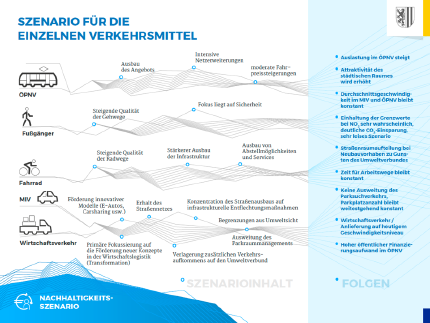Leipzig Looks Ahead to 2030 – Unanimously!
‘Leipzig Kommt!’ or ‘Leipzig hat Zukunft’ were monikers I recall seeing dotted on posters around the city in the early 1990s. Once again, the city is experiencing strong population growth, as it did over a century ago. But with many new residents counting on being able to continue driving their cars, the city authority foresees gridlock within years.
For this reason, Stadt Leipzig has adopted a new strategy to tackle the growing crisis, seeking to guarantee ‘Mobility is safe, reliable, clean, affordable and should ensure that every population group has the opportunity to participate in.’ On Thursday, September 27th, 2018, it was welcomed by the city council - unanimously.
In the run-up, three years were spent researching transport futures (hyperlinks to German text), consulting with experts, members of the city council and citizens, and as a result, developing six scenarios for councillors to consider. The ‘Nachhaltigkeits-Szenario’ or sustainability scenario, is the preferred path to the future. Reflects Wolfgang Backhaus, Project Manager of the Interreg CE LOW-CARB project, “The scenario is wholly in line with our LOW-CARB ambitions!”
In essence, the concept – now to be put into practice – is aimed at the expansion of local public transport and strengthening cycling and walking without, however, worsening the conditions for individual car and commercial transport. Investments of some one billion euros by 2030 are expected to increase the number of bus and tram passengers from 156 to 220 million per year, reduce the share of car traffic from 40 to 30 percent, increase the modal share of public transport and bicycle traffic to 23 percent each (currently they are 17-18 percent) and walking to 24 percent. Over the next year, pre-planning and the prioritization of investments that will also reduce noise and pollution will follow. However, attention will also be accorded to motivating individuals to choose more sustainable modes. Therefore, annual public transport fare increases will be capped at two per cent.
City Councillor, Axel Dyck, recognises the need for Leipzig to keep up with other European cities that already offer, for example, free public transport, bicycle friendly streets, light-rail services and car-free zones. "Something is happening everywhere. The end of urban road traffic, as we know it today, is inevitable. We have to act and we want to act." But where Leipzig came up trumps was in its undertaking of such a scenario process – something no other German city has done. The ‘Mobilitätsstrategie 2030’ closely follows the Stadtentwicklungsplan Verkehr und öffentlicher Raum (Sustainable urban Masterplan for Transport and Public Spaces), Nahverkehrsplan (draft Public Transport Masterplan) and Bevölkerungswachstum (population growth forecast).
Ronald Juhrs, Managing Director for Technology and Operations at LOW-CARB’s lead partner organisation, Leipziger Verkehrsbetriebe (LVB) GmbH, shared his excitement at the decision: “Within the dynamic industrial area to the north of the city, we are busy looking into how to ensure public transport services its 35,000 commuters. Together with Stadt Leipzig and the regional travel authority, Mitteldeutscher Verkehrsverbund GmbH (MDV), a low-carbon action plan is under preparation, for which consultations already got underway during EUROPEANMOBILITYWEEK. We are also developing a multimodal online tool that will facilitate shared and seamless mobility which we look forward to piloting. The adoption of the 2030 strategy naturally bolsters our own ambitions.”
Thanks to Klaus Staeubert of Leipziger Volkszeitung and René Loch of the Leipziger Internet Zeitung for their contributions.

The 2030 goal: ‘Mobility is safe, reliable, clean, affordable and should ensure that every population group has the opportunity to participate in.’
